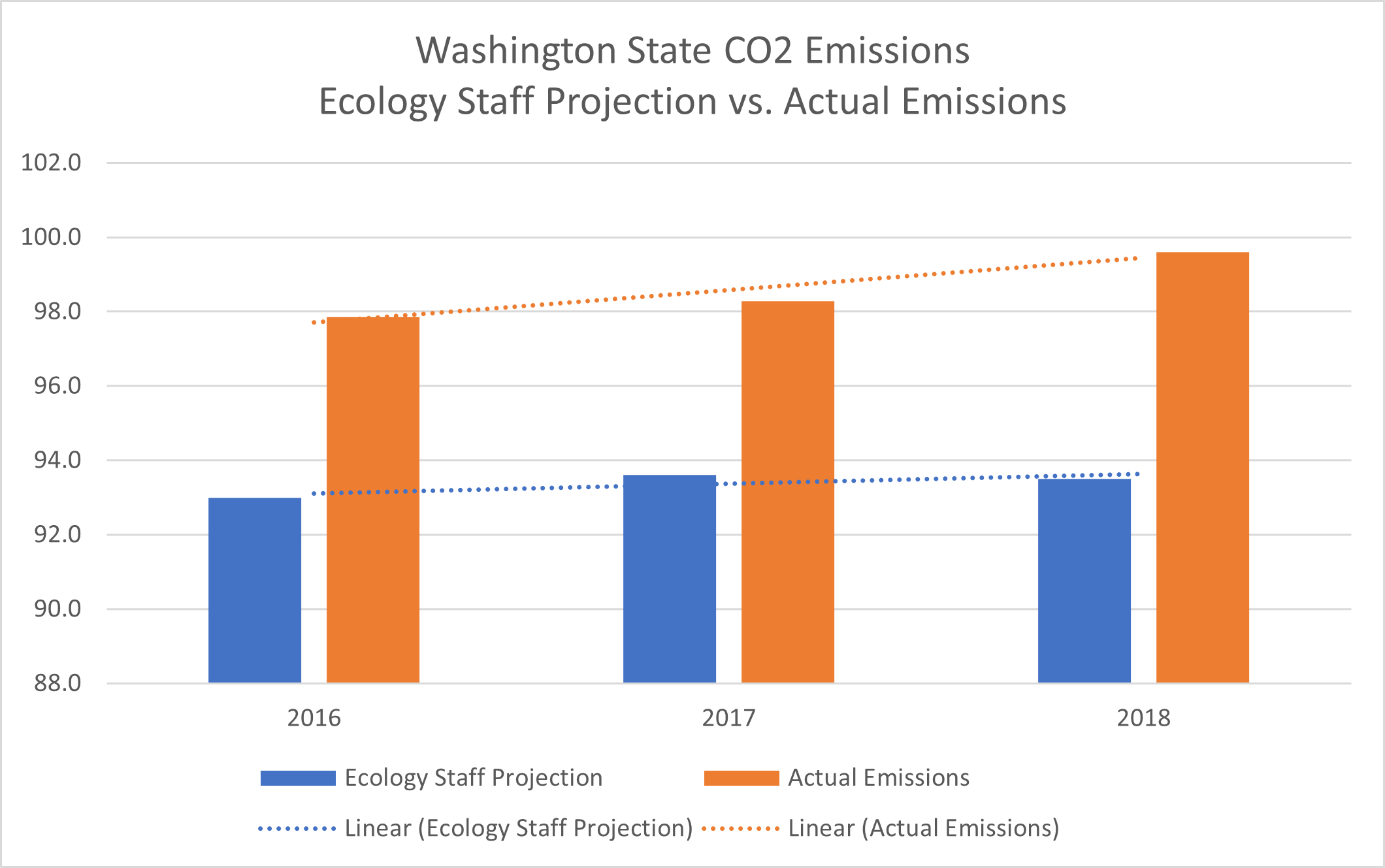Despite reporting CO2 emissions that are the highest in a decade, the Washington State Department of Ecology (DOE) promises the state is “Turning the corner.” Considering their repeated failure over the years to accurately predict emissions, this claim is truly remarkable. A quick look at recent predictions makes it clear that legislators should not take seriously DOE projections about emissions or the potential impact of climate policies.
The recently released CO2 data from 2018 show Washington residents emitted 99.6 million metric tons (MMT) of CO2, a 1.3 percent increase from 2017 and higher than any year since 2007. Despite that, DOE staff promise that emissions will decline in the near future. They write, “in recent years, Washington has adopted a number of new policies designed to reduce greenhouse gas emissions. If emissions are going up, are those policies really working? Yes, our carbon reduction policies are, in fact, working.”
Given their record of predictions, their certainty can only be described as hubris.
Despite believing they can accurately predict the future, Ecology staff had a difficult time correctly calculating data two years ago. Last November, the Department of Commerce released their draft Energy Strategy, which included an estimate from the DOE calculating Washington’s 2018 CO2 emissions at 98.9 MMT, up from 98.3 MMT in 2017.
Just two months later in January, the DOE released the final emissions total of 99.6 MMT, an increase of 0.7 MMT of CO2 since the November estimate. This is not small. It doubles the increase between 2017 and 2018 and is the equivalent of CO2 emissions from more than 150,000 cars for a year.
The data they are reporting are two years old, yet agency staff are still having difficulty providing an accurate assessment. To be sure, these numbers can be complicated for a number of reasons. However, the inability to determine data that is two years old should discourage the agency from making confident predictions about what will happen 10 years from now. Sadly, it does not.
This isn’t the first time DOE staff has promised that we were about to see a decline in emissions.
Just last year, when announcing the 2017 emissions data, former Ecology Director Maia Bellon promised, “What we’re seeing is that our state’s carbon reduction strategies are beginning to pay off.” Instead, CO2 emissions increased significantly in 2018.
 In 2018, I requested the emissions data and projections from DOE staff. Although emissions had been increasing through 2015, they assured me that “2016 is a key year in the forecast” because the state law requiring an increase in renewable sources of electricity would become more strict. The projection they sent to me promised a reduction from 2015 to 2016 and then flat emissions through 2018.
In 2018, I requested the emissions data and projections from DOE staff. Although emissions had been increasing through 2015, they assured me that “2016 is a key year in the forecast” because the state law requiring an increase in renewable sources of electricity would become more strict. The projection they sent to me promised a reduction from 2015 to 2016 and then flat emissions through 2018.
Those projections were off by a large margin. Rather than declining, emissions continued to increase. For 2018, DOE’s projection was off by 6.1 MMT – the equivalent of emissions from more than 1.3 million cars for a year. That is an enormous error.
Projections are difficult, and the large gap between their predictions and reality is evidence of that. Despite those challenges, DOE staff continue to confidently promise that the policies they advocate for are effective, that we are “turning the corner,” and that the costly policies they will propose will have “no unintended consequences,” as one member of DOE staff told legislators recently.
This consistent pattern of failed projections should be a warning to legislators that relying on DOE projections is extremely risky. Trying to accurately predict the future has proven to be a fool’s errand, but in the words of Obi Wan Kenobi, “Who’s the more foolish, the fool? Or the fool who follows him?”





